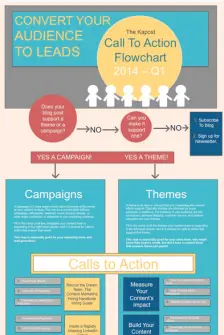The Secret Weapon to Superior Calls to Action
Great content marketing campaigns engage your target audience and build trust and authority online by educating that audience.


But for the data-driven marketer, the real goal of content marketing is generating leads, qualified opportunities, and revenue dollars. And to drive these quantifiable results, you need to compel people in your pipeline to take actions that will move them through the funnel.
Without a strong call to action, you’re not giving your content a fair chance to convert unique visitors into leads in your database. And that, my friends, is a problem. Especially if you’re fighting for budget, or need to justify the spend on a content-centric marketing strategy. This post explains 3 ways to make your CTAs powerful lead and revenue drivers for your organization.
Start with Goals
One of my main responsibilities at Kapost is managing our content marketing blog, the Content Marketeer. The blog is the hub of our efforts. We want to drive our target audience there, engage them with content that’s relevant to them, and get them into our sales and marketing funnel.
Since I oversee the Content Marketeer, its success is important to me—which means conversions are important to me. If our content doesn’t deliver leads, qualified opportunities, and ultimately revenue, then I’m not doing my job.
Getting the right CTAs starts with knowing exactly what we need to do. How many leads do we need to drive this month, this quarter? What percent of our leads (based on historical data) come from our blog? We use this information to set goals. This holds me and our entire content marketing team accountable for how well our content drives conversions.
Once you know the goals you’re measured on, the value of a call to action becomes much more quantifiable. If there are ways to increase the number of people who click-through to a landing page and become leads, or more importantly, qualified leads that result in opportunities—you better be doing it.
Conduct Analysis
Another important piece of the call to action puzzle is understanding the language that gets people to convert. Dig into your data, and use A/B tests to determine what actually drives your users to act.
For example, each month I track how our CTAs are performing on the Content Marketeer. One of the reports focuses on the calls to action at the end of our blog posts. Here’s an example:

This is one of our top three calls to action, with a click-through rate of 8.18%. First, I look at the top performing calls to action. Which have the most click-throughs? How about conversion rates? Is there something different about these calls to action? How about the posts they’re associated with?
In my most recent analysis, we found three main takeaways for calls to action on our blog. We track through two methods: (1) by pulling data from Kapost, including clicks to landing pages and custom fields that help us understand what, exactly, is working on our blog posts, for example, CTA language, word count, etc. and (2) setting up “events” in Google Analytics to get a broader picture of how users come to and then interact with our owned domains.
1. Use the Word “Get”
Of the top 15 calls to action, the word “get” was in 10 of them. That’s more than 66% of our highest performing calls to action. Also, the word “your” was used in 9 of them. Given this information, it shouldn’t come as a surprise that “Get your” was our most effective word combination.
2. Use Visuals
I was curious to find out if anything in the blog posts themselves correlated with action. First of all, we always align our CTAs with a campaign or theme, so it’s always relevant to the text in the blog posts (more on that below). But another key discovery was that blog posts containing large visuals consistently show up as top performers. In fact, 73% of the top blog posts (in terms of click-throughs on our CTAs) contained either a large custom image, infographic, or embedded SlideShare presentation.
3. Word Count Doesn’t Matter
On the Content Marketeer, we play around with the length of our blog posts. We publish short, lighter pieces as well as in-depth, long-form posts. As part of my analysis, I wanted to know if length affects whether or not people take that next step. Turns out, it doesn’t. Of our top performing posts, word count ranged from 95 to 1,590 words, with the average at 508 words.
Our Secret Weapon: The Call to Action Flowchart
I think of the CTA as the threshold: will your reader cross it into the next stage of their journey? As content marketers, we want to make that transition as seamless and fluid as possible. With that in mind, we always make sure that we have a relevant call to action, leading to a relevant larger asset, at the end of each blog post.
To help get readers over that threshold, my colleague Jean Spencer created a nifty little tool called a Call to Action Flowchart. It helps us determine relevant calls to action for each asset we produce.
Internally, it’s best practice for us to create content that fits into at least one of these two categories: (1) A larger content campaign and (2) a content theme. Because content that’s part of a content pillar campaign always has a gated asset associated with it, the flowchart is most useful for option two.

The goal is twofold: to link to a relevant, gated asset and to use the most effective language to drive action. We create a new flowchart every quarter, updating it with all new assets that have been produced. To create your own, get your template here. (See what I did there?)
Set goals for your content. Dig into the data using content intelligence. Present your readers with relevant, effective calls to action. By understanding the kinds of calls to action that deliver and when they’re most effective, you’ll be able to quickly and easily optimize your content to drive more click-throughs and conversions.
Get going today—and find out exactly what drives your audience to take those valuable actions.
